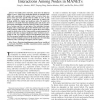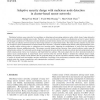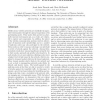147
Voted
TSMC
2010
14 years 7 months ago
2010
In mobile ad hoc networks, nodes have the inherent ability to move. Aside from conducting attacks to maximize their utility and cooperating with regular nodes to deceive them, mali...
102
Voted
JCIT
2010
14 years 7 months ago
2010
In peer-to-peer networks, it is very difficult to route query successfully, since nodes in the routing path do not always behave according to pre-established routing protocols. To...
93
Voted
GLOBECOM
2009
IEEE
14 years 10 months ago
2009
IEEE
Collaborative spectrum sensing in cognitive radio networks has been proposed as an efficient way to improve the performance of primary users detection. In collaborative spectrum se...
123
click to vote
SECON
2010
IEEE
14 years 10 months ago
2010
IEEE
Data aggregation in wireless sensor networks is vulnerable to security attacks and natural failures. A few nodes can drastically alter the result of the aggregation by reporting er...
137
click to vote
INFOCOM
2010
IEEE
14 years 10 months ago
2010
IEEE
Network coding has been shown to be capable of greatly improving quality of service in P2P live streaming systems (e.g., IPTV). However, network coding is vulnerable to pollution a...
102
Voted
CORR
2010
Springer
14 years 11 months ago
2010
Springer
Due to lack of the infrastructure, open peer-to-peer architecture, shared wireless medium, limited resource constraints and highly dynamic topology, MANETs (Mobile Adhoc Networks) ...
114
click to vote
COMCOM
2007
15 years 7 days ago
2007
Distributed wireless sensor networks have problems on detecting and preventing malicious nodes, which always bring destructive threats and compromise multiple sensor nodes. Theref...
106
click to vote
IJNSEC
2006
15 years 19 days ago
2006
Mobile ad-hoc wireless networks are established in improvised environments through the mutual cooperation of its participating nodes. These nodes often operate in a physically ins...
116
Voted
APNOMS
2006
Springer
15 years 4 months ago
2006
Springer
In Ad hoc networks, malicious nodes can enter in radio transmission range on the routing path and disrupt network activity. Therefore, protecting from intrusion of malicious node a...
169
Voted
ACSC
2004
IEEE
15 years 4 months ago
2004
IEEE
An ad-hoc network comprises mobile nodes that cooperate with each other using wireless connections to route both data and control packets within the network. As the low transmissi...



